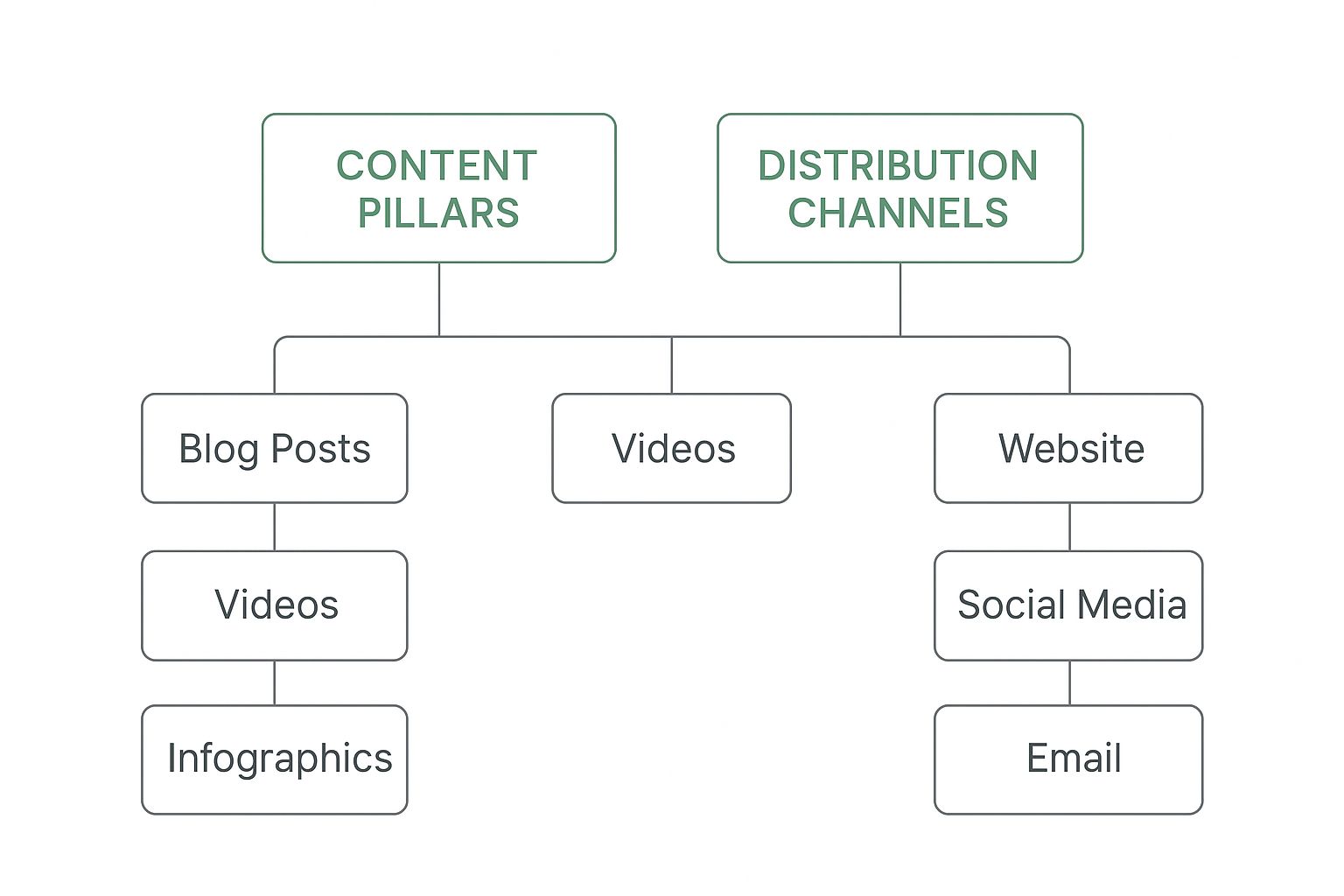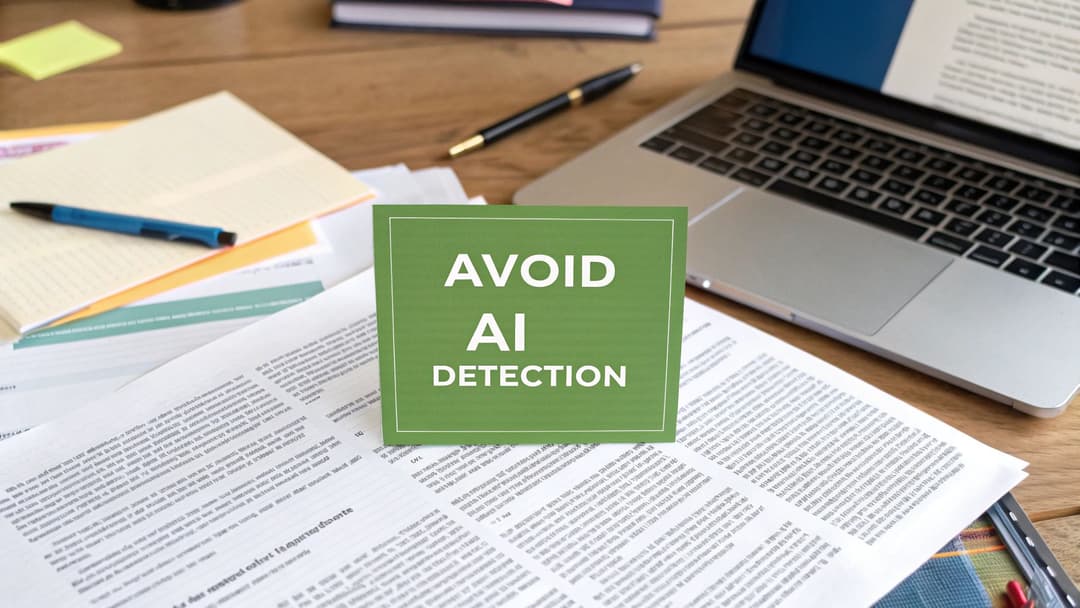
What Is Content Marketing Strategy?
August 21, 2025
A content marketing strategy is just a documented plan for how you’ll use content—blog posts, videos, social media—to hit your business goals. It's the blueprint that guides everything you create, making sure every single piece has a purpose.
Defining Content Marketing Strategy Without the Jargon
Think of it this way: your business is a destination, and your content is the car. Without a map, you’re just driving around, burning gas and hoping you stumble upon where you want to go. A content marketing strategy is that map. It’s your documented path, showing you exactly how to create and share content to attract, engage, and ultimately win over your ideal customers.
This is the critical difference between just making stuff and making stuff that actually works. You shift from tossing random content out into the world to building a deliberate, cohesive system designed for real, measurable results.
A solid strategy forces you to answer the big questions before you ever write a single word:
- Who are we actually talking to?
- What problems are we solving for them?
- Why should they listen to us instead of the competition?
- How will we know if any of this is working?
The Blueprint for Growth
When you have a well-defined strategy, content stops being an expense and starts becoming a valuable business asset. It forces you to connect every article, tweet, and video to a specific business objective, like boosting website traffic by 20% or generating 50 new leads a month.
This is what turns your content from a guessing game into a predictable engine for growth.
A goal without a plan is just a wish. Your content marketing strategy is the plan that turns the wish of "getting more customers" into an actionable, repeatable process.
Without that foundation, you’re just creating content that nobody sees or cares about, which is a massive waste of time and money. The table below really drives home the difference between a planned approach and just winging it.
Random Content Creation vs. Strategic Content Marketing
It's easy to confuse being busy with being effective. Pushing out content without a plan feels productive, but it rarely moves the needle. A strategy, on the other hand, ensures every effort is pointed in the right direction.
| Aspect | Random Content Creation | Strategic Content Marketing |
|---|---|---|
| Foundation | Based on assumptions or what's trending | Based on real audience research and data |
| Goal | "We need a blog post this week." | "Increase organic leads by 15% this quarter." |
| Topics | Whatever seems interesting today | Aligned with specific, pre-defined content pillars |
| Measurement | Vanity metrics (likes, views) | Business KPIs (leads, sales, ROI) |
| Outcome | Inconsistent results, wasted effort | Predictable growth and lasting brand authority |
As you can see, one path leads to burnout and inconsistent outcomes, while the other leads to sustainable, predictable success. A strategy is what gives your content a fighting chance to make a real impact on your business.
Why a Documented Strategy Is a Non-Negotiable Asset
An idea floating around in your head isn't a strategy—it's just a thought. To truly turn your content from a hopeful expense into a measurable, revenue-generating machine, you need a documented plan. This written blueprint is often the single biggest factor separating content programs that succeed from those that just fizzle out.

Without a documented strategy, teams end up operating in silos. The social media manager posts about one topic, the blogger writes about another, and the video team creates something that feels completely disconnected. The result is a confusing, disjointed brand experience for your audience. A written plan acts as the central source of truth, pulling everyone together toward the same goals.
This clarity is also crucial for getting the resources you need. When you can walk into a meeting with a clear, documented plan showing how your content will drive real business outcomes—like generating leads or keeping customers around longer—it becomes much easier to justify your budget and prove your department's value.
From Chaos to Cohesion
Imagine a construction crew trying to build a house without architectural plans. One person starts laying bricks for a wall, another begins digging a foundation for a totally different room size, and the plumber is just guessing where the kitchen will be. The project would be doomed from the start.
That chaotic scene is exactly what content marketing looks like without a documented strategy. A written plan provides the structure and direction needed for consistently great work. It outlines your goals, target audience, key messages, and how you’ll measure success. This framework empowers your team to create cohesive content that builds on itself over time.
A documented strategy doesn't just guide your content; it creates a shared understanding of what success looks like. It turns ambiguous goals into concrete action steps every single team member can follow.
This focused approach is more critical than ever. The global content marketing market is projected to explode to $2 trillion by 2032, growing at a staggering 16.9% annually. With that much noise, companies without a clear plan will be completely drowned out by those with a strategic, documented vision. You can find more insights in these content marketing statistics and trends.
The Tangible Business Impact
At the end of the day, a documented strategy is all about driving tangible business results. It draws a clear line between the content you create and the bottom line.
Here’s how a written plan makes a real-world difference:
- Creates Accountability: It spells out who is responsible for what, from creation and promotion all the way to measurement. No more finger-pointing.
- Enables Scalability: A clear process lets you onboard new team members quickly and expand your content efforts without everything falling apart.
- Improves Decision-Making: When someone pitches a new idea, you can hold it up against the strategy. Does it align with your core objectives? If not, it's an easy "no."
- Fosters Consistency: It ensures your brand voice, tone, and messaging stay the same across all channels, which is how you build trust with your audience.
Putting your plan on paper creates a powerful asset that guides your team, justifies your budget, and builds a direct path to sustainable growth. You can learn more about putting this into action in our guide on content marketing best practices. This is how you stop performing random acts of content and start building a predictable, successful program.
The 7 Core Components of a Powerful Content Strategy
A winning content strategy isn’t a single brilliant idea. It’s a machine built from several interconnected parts, all working in sync. Each component answers a critical question, and when you put them all together, you have a complete playbook for creating content that actually works.
Think of them as the chapters that guide every single piece of content you produce. Breaking it down this way makes the whole process feel less overwhelming and ensures you don't skip a crucial step.
1. Audience Personas
Before you write a single word, you have to know who you’re talking to. Audience personas are detailed, semi-fictional profiles of your ideal customers. They go way beyond basic demographics to uncover what your audience truly cares about—their goals, frustrations, and motivations.
This is the foundational step. A well-defined persona for, say, "Marketing Mary" helps you understand her daily challenges, what kind of content she actually finds helpful, and where she’s already looking for answers online. This deep understanding is the difference between content that resonates and content that just feels generic.
2. Business Goals and KPIs
Content without a goal is just noise. Your strategy has to be tied directly to measurable business objectives. Are you trying to boost brand awareness? Generate qualified leads? Keep customers coming back? Each goal demands a completely different approach to content.
Once you’ve set your goals, you need Key Performance Indicators (KPIs) to see if you’re on the right track.
- For brand awareness: You might track website traffic, social media reach, or mentions.
- For lead generation: You’d be watching form submissions, email sign-ups, or demo requests.
- For customer retention: Your focus would be on repeat purchases or customer lifetime value.
These metrics are your proof of performance. They show you exactly how content is contributing to the bottom line.
3. Content Pillars
You can't be an expert in everything. Content pillars are the 3-5 core topics your brand can genuinely own. These are the broad themes directly related to what you sell and what your audience is desperate to learn about.
For instance, a project management software company might build its content around pillars like "Team Productivity," "Agile Methodologies," and "Leadership." Every piece of content—from blog posts to videos—should tie back to one of these pillars. This focus builds topical authority with search engines and, more importantly, establishes your brand as the go-to resource in your space.
4. Format and Channel Plan
With your pillars locked in, it's time to decide how and where you’ll deliver your message. This is your format and channel plan. A long-form article that’s perfect for your blog and SEO would fall completely flat as an Instagram post. Short, punchy videos, on the other hand, are ideal for social media.
This diagram shows the simple relationship between your core topics (pillars), the formats you create, and the channels you use to get them out there.

As you can see, your pillars inform the formats you create, which are then published on the channels where they'll have the most impact. It’s all about making sure your message is perfectly suited to its environment.
5. Content Creation Workflow
Great ideas are worthless without a system to bring them to life. A content creation workflow is your documented, step-by-step process for taking a piece of content from a spark of an idea to a published asset. It clarifies who does what, outlines review stages, and sets deadlines.
A documented workflow prevents bottlenecks and ensures consistent quality. It’s the assembly line that turns your strategic plans into high-quality, published content, on time, every time.
Without a workflow, projects stall, quality suffers, and your team is stuck in a state of reactive chaos. This is the system that makes your content strategy scalable.
6. Distribution and Promotion Plan
Creating great content is only half the battle. Hitting "publish" is the starting line, not the finish. Your distribution and promotion plan is your game plan for getting your content in front of your target audience.
A smart plan includes a mix of channels:
- Owned Media: Your email list, website, and social media profiles.
- Earned Media: Guest posting, PR outreach, and organic social shares.
- Paid Media: Social media ads, paid search, and influencer marketing.
A strong distribution plan ensures your valuable content doesn’t just sit on your blog gathering dust. For a deeper look, check out our guide on building a complete digital marketing content strategy.
7. Measurement and Analysis
Finally, you have to measure what's working—and what isn't. The measurement and analysis piece is where you regularly review your KPIs against your business goals. This is where tools like Google Analytics become your best friend, helping you track traffic, engagement, and conversion rates.
This data-driven feedback loop is what keeps a strategy alive and effective. By analyzing performance, you can spot your best-performing content, understand which topics resonate most, and discover new opportunities. You then double down on what works and cut what doesn't, continuously optimizing your strategy for better and better results.
Alright, let's get down to business. Theory is great, but putting it into practice is what really counts. It's time to roll up our sleeves and actually build your content marketing strategy, turning all those abstract ideas into a concrete plan you can use today.
Think of this as the workshop phase. We're going to walk through the foundational steps that give every blog post, video, and social media update a clear purpose.

Step 1: Define Your Mission And Goals
First things first: you have to know why you’re creating content. What's the point? Your content marketing mission is a short, simple statement that clarifies who you’re talking to, what you’re giving them, and the result you want.
For example, a mission could be: "To provide small business owners with actionable, easy-to-understand marketing advice that helps them grow their revenue." It's clear and focused.
With that mission set, you need specific, measurable goals. Vague ambitions like "get more traffic" won't cut it. They’re useless. Instead, use the SMART framework to get real:
- Specific: Increase organic blog traffic from new users.
- Measurable: Achieve a 25% increase in organic traffic.
- Achievable: Based on our resources, this target is realistic.
- Relevant: More traffic directly supports our bigger goal of generating leads.
- Time-bound: We will accomplish this within the next quarter.
These goals become your North Star, guiding every single decision from here on out.
Step 2: Conduct Deep Audience Research
You simply can't create content that connects if you don't know who you're talking to. You have to go deeper than basic demographics. What are their biggest pain points? What questions are they frantically typing into Google at 2 AM?
Here's how to get real answers:
- Survey Your Current Customers: Just ask them. Find out about their challenges and what kind of content they actually find helpful.
- Analyze Your Website Analytics: Look at what’s already working. Which pages are most popular? What search terms are people using to find you?
- Monitor Social Media and Forums: Pay attention to the language your audience uses. Hang out where they hang out, whether that's on Reddit, LinkedIn, or niche forums.
All this intel feeds into your buyer personas, giving you a crystal-clear picture of the person on the other side of the screen.
A deep understanding of your audience is the single most important element of a successful content strategy. It ensures you're creating content for them, not just at them.
Step 3: Perform A Content Audit And Gap Analysis
Chances are, you already have some content on your site. Before you dive into creating anything new, you need to take stock of what you've got. A content audit is just a fancy term for inventorying and evaluating all your existing stuff.
Go through each piece and sort it into one of three buckets:
- Keep: This is the good stuff. It's high-performing and still relevant.
- Update: Solid content that's just a bit outdated or could be improved.
- Delete: Low-quality or irrelevant content that's actually hurting your site.
Once you know what you have, a gap analysis shows you what you're missing. Compare your current content library to your buyer personas' journey. Where are the holes? Maybe you're great at answering initial questions but have nothing to help them make a final purchase decision. This is where you'll find your biggest content opportunities.
Step 4: Brainstorm Ideas And Choose Formats
Now the fun begins. With your goals, audience, and content gaps defined, it’s time to start brainstorming. This is where you connect your big-picture content pillars to specific topics. If one of your pillars is "Team Productivity," you could come up with topics like "Best Tools for Remote Collaboration" or "How to Run More Effective Meetings."
Brainstorming and curating great ideas is a huge part of the process, especially for fast-moving platforms. If you're stuck, there are plenty of excellent resources for generating content ideas for social media that can get your creativity flowing.
Next, think about the best format for each idea. Is it a detailed blog post? An engaging video? A shareable infographic, or maybe a downloadable checklist? The right format always depends on the topic's complexity and what your audience actually prefers.
Step 5: Create A Content Calendar
A content calendar (or editorial calendar) is your roadmap. It’s a schedule that outlines exactly when and where you'll publish everything. This is the tool that turns your strategy into an actionable, day-to-day plan. It keeps your team on the same page and guarantees a consistent publishing rhythm.
Here's a handy checklist to help you structure your own strategy development process.
Content Strategy Development Checklist
| Step | Action Item | Key Consideration |
|---|---|---|
| 1. Goals & Mission | Write a clear content mission statement. | Who is your audience and what outcome will you provide for them? |
| Set 3-5 SMART goals for the next quarter. | Are they specific, measurable, achievable, relevant, and time-bound? | |
| 2. Audience Research | Create 1-3 detailed buyer personas. | What are their biggest pain points, questions, and motivations? |
| Survey at least 10 existing customers. | What content do they value most from you or your competitors? | |
| 3. Content Audit | Inventory all existing content assets. | What can be kept, updated, or deleted? |
| Identify 3-5 key content gaps. | Where are you failing to answer your audience's questions? | |
| 4. Ideation | Brainstorm 20+ topic ideas for your pillars. | How can you solve your audience's problems with content? |
| Match each topic idea to a primary format. | Is this best as a blog post, video, infographic, or something else? | |
| 5. Planning | Draft a content calendar for the next month. | What gets published, when, and by whom? |
| Define your promotion channels for each piece. | How will you get this content in front of the right people? |
This simple calendar brings order to the chaos of creation. It's the operational heart of your content marketing machine, helping you manage workflows and keep the momentum going.
How to Budget for Your Content Marketing Efforts
A great content marketing strategy is just a plan on paper without the right resources to bring it to life. Budgeting for content can feel a little tricky, but it’s really about making smart investments in the areas that will actually move the needle for your business.
Think of your budget as the fuel for your content engine. You need to account for everything from the software you use to the people creating the work. A well-planned budget is what allows you to consistently produce high-quality content, get it in front of your target audience, and ultimately hit your business goals.
Where Does the Money Actually Go?
The first step in building a realistic budget is understanding where the money typically goes. Your investment will usually be split across a few key categories, and each one plays a vital role in turning your strategy into a reality.
Common budget items include:
- Content Creation: This is almost always the biggest slice of the pie. It covers costs for your in-house writers, freelance talent, graphic designers, and video producers.
- Software and Tools: You can't do modern marketing without the right tech. This bucket includes essential tools for SEO research (like Ahrefs or Semrush), project management (like Trello or Asana), analytics, and AI assistants.
- Paid Promotion: Creating brilliant content is only half the battle. You have to promote it. This line item is for social media ads, search engine marketing, and influencer collaborations to get more eyes on your work.
- Video Production: Video is no longer a "nice to have." As it becomes more dominant, costs for equipment, editing software, and on-camera talent are becoming a standard part of most marketing budgets.
A budget isn't a restriction; it's a strategic tool. It forces you to prioritize what's most important and ensures every dollar you spend is directly tied to a specific business objective.
Allocating Funds for Maximum ROI
How you split up your budget should be a direct reflection of your goals. If your main objective is to generate leads, you might pour more money into creating in-depth ebooks and webinars. If brand awareness is the priority, a bigger chunk of your budget will probably go toward producing shareable videos and social media content.
And businesses are putting their money where their mouth is. Recent data shows that 46% of B2B marketers plan to increase their content marketing spend, while another 41% expect their budgets to stay the same. That’s a huge vote of confidence.
The biggest spending increases are slated for video (61%), thought leadership (52%), and AI-driven tools, which gives you a pretty clear picture of where modern strategies are heading. You can explore the full content marketing statistics and see the trends for yourself.
Of course, budgeting is just one piece of the puzzle. You also need clear metrics to prove it's all working. To justify your investments, you have to connect the dots between spending and results. For instance, if a big part of your budget is going to social media, knowing how to measure social media ROI is non-negotiable.
When you can tie your spending to tangible outcomes, you can make smarter decisions, prove your content's value, and build a much stronger case for future investment.
Adapting Your Strategy for Modern Audiences
A great content marketing strategy isn't a static document you file away and forget. It has to be a living, breathing plan that evolves, especially as the people you’re trying to reach change how they find information. The tactics that worked five years ago are likely to fall flat with today's audiences, particularly younger generations who have entirely new ways of discovering products and ideas.

The biggest shift? Social media. For a huge chunk of your audience, platforms like TikTok, Instagram, and YouTube aren't just for entertainment anymore—they’re the new search engines. Instead of typing a question into Google, they're searching directly inside these apps for reviews, how-to videos, and recommendations.
This means your strategy has to look beyond traditional blogging and SEO. If your ideal customer is discovering new brands through short-form video, you absolutely need to be there, creating content that speaks their language.
Meeting Audiences on Their Terms
Adapting to this new reality is all about creating platform-native content. Just dropping a link to your latest blog post across all your social channels is a surefire way to get ignored. A smart, modern strategy respects the unique culture and format of each platform.
What works where? It's all different:
- TikTok and Instagram Reels: Think short, authentic, and often entertaining videos that deliver a quick punch of value.
- YouTube: This is where you can go deeper with in-depth tutorials, product deep-dives, and behind-the-scenes content that builds a real community.
- LinkedIn: Here, it’s all about professional insights, industry analysis, and content that helps people get ahead in their careers.
The goal is to provide value in the exact context your audience is already in. This requires a deep understanding not just of who they are, but how they consume media. You also have to nail the what is tone in writing for each platform if you want to sound authentic and build a genuine connection.
Today's audiences don't just want content; they want community. Building a space for genuine interaction and conversation around your content is far more powerful than simply broadcasting a message.
The Rise of Creator Collaborations
Authenticity is everything, which is exactly why creator and influencer partnerships are crushing it right now. Modern consumers, especially Gen Z, are deeply skeptical of polished corporate ads. They trust recommendations from real people they already follow and admire.
The data backs this up. 59% of marketers are planning to increase their influencer marketing budgets. Why? Because social media content heavily influences the purchase decisions of 76% of users—a number that skyrockets to an incredible 90% for Gen Z. In fact, 41% of Gen Z now turn to social media as their primary source for information, beating out traditional search engines. You can dig into more of these stats on shifting consumer behaviors on Marketing Dive.
Bringing creators into your content strategy lets you tap into pre-built trust and reach highly engaged communities. It’s a powerful way to make sure your message feels genuine and actually connects with people who would otherwise tune out traditional brand messaging. By staying flexible and embracing these new channels, your strategy will stay not just relevant, but effective.
Frequently Asked Questions
Even with the best plan in hand, questions are bound to come up. Let's tackle some of the most common ones that pop up when you're building a content marketing strategy.
How Long Should a Content Marketing Strategy Be?
This is a classic "it depends" situation. There’s no magic page count. A small business might only need a tight, 5-10 page document, while a massive enterprise could be working off a 50-page bible.
The real goal isn't length, it's clarity. Your strategy needs to be detailed enough to give your team clear direction, but simple enough that they'll actually read and use it. If it clearly outlines your goals, who you're talking to, what you'll talk about, where you'll publish, and how you'll measure success, it’s long enough.
What’s the Difference Between a Content Strategy and an Editorial Calendar?
Think of it like an architect's blueprint versus the construction crew's work schedule.
- A Content Strategy is your high-level blueprint. It's the "why" behind everything. It defines your core goals, your audience, and the big-picture topics you want to own.
- An Editorial Calendar is the day-to-day schedule. It answers "when" and "where." It maps out specific articles, videos, or posts, assigns deadlines, and tells everyone what’s coming up next.
One guides the other. You can't have an effective calendar without a solid strategy, and a strategy is just a document until a calendar puts it into motion.
How Often Should I Update My Strategy?
Your content strategy should be a living, breathing document—not a "set it and forget it" file that gathers digital dust. Plan on doing a major review once a year. This is your chance to zoom out and make sure your plan still aligns with the company's big goals and any major shifts in the market.
But don't wait a full year to make tweaks. You should be checking in much more often. A quarterly review is perfect for digging into the data, seeing what's resonating, and making smart adjustments. If a channel is underperforming or a new content format is suddenly hot, you need the agility to pivot. These regular check-ins are what keep your strategy sharp and effective.
Ready to create content that sounds truly human? Natural Write is a free tool that instantly refines AI-generated text into natural, engaging language that bypasses AI detectors with ease. Polish your blog posts, marketing copy, and essays in a single click. Visit us at https://naturalwrite.com to start humanizing your content today.


